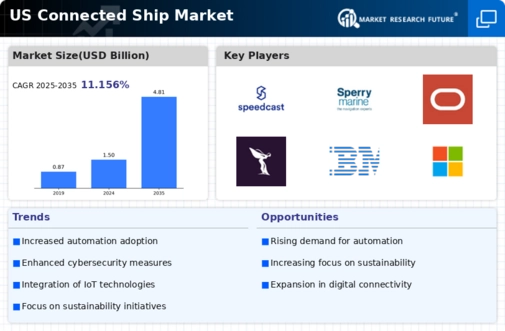Advancements in Data Analytics and AI
the connected ship market is propelled by advancements in data analytics and artificial intelligence (AI).. These technologies enable shipping companies to harness vast amounts of data generated from connected vessels, leading to improved decision-making and predictive maintenance. The integration of AI algorithms can enhance route optimization, resulting in reduced travel times and fuel consumption. As a result, companies are likely to see a potential decrease in operational costs by up to 10%. The ongoing evolution of data analytics tools is expected to further drive the adoption of connected technologies, as companies seek to leverage data for competitive advantage.
Rising Demand for Operational Efficiency
the connected ship market is seeing a notable surge in demand for operational efficiency among shipping companies.. This trend is driven by the need to optimize fuel consumption, reduce operational costs, and enhance overall productivity. According to recent data, shipping companies that have integrated connected technologies report a reduction in fuel costs by up to 15%. The implementation of real-time data analytics and monitoring systems allows for better decision-making, which is crucial in a competitive landscape. As the industry continues to evolve, the focus on operational efficiency is likely to remain a primary driver, pushing more companies to adopt connected solutions to streamline their operations.
Increased Focus on Safety and Risk Management
Safety and risk management are paramount in the connected ship market, as shipping companies strive to mitigate risks associated with maritime operations. integrating connected technologies enhances situational awareness, allowing for real-time monitoring of vessel conditions and potential hazards.. This focus on safety is underscored by the fact that incidents at sea can lead to substantial financial losses, estimated at millions of dollars per incident. Consequently, companies are investing in connected solutions that provide advanced safety features, such as collision avoidance systems and emergency response protocols. This trend is likely to continue as the industry prioritizes safety and risk mitigation.
Growing Investment in Smart Shipping Solutions
the connected ship market is seeing a growing investment in smart shipping solutions, driven by the need for innovation and technological advancement.. Shipping companies are increasingly allocating budgets towards the development and implementation of connected technologies that enhance operational capabilities. It is projected that investments in smart shipping solutions could reach $10 billion by 2027, reflecting a robust growth trajectory. This influx of capital is likely to foster innovation, leading to the development of new applications and services within the connected ship market. As companies seek to remain competitive, the emphasis on smart solutions is expected to be a key driver of market growth.
Regulatory Compliance and Environmental Standards
the connected ship market is heavily influenced by stringent regulatory compliance and environmental standards imposed by governmental bodies.. In the US, regulations such as the International Maritime Organization's (IMO) 2020 sulfur cap have prompted shipping companies to adopt connected technologies that facilitate compliance. These technologies enable real-time monitoring of emissions and fuel usage, ensuring adherence to environmental regulations. The market is projected to grow as companies invest in connected solutions to avoid hefty fines and enhance their sustainability profiles. It is estimated that compliance-related investments could account for approximately 20% of the total expenditure in the connected ship market.






















Leave a Comment